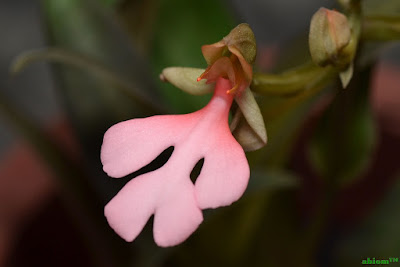Habenaria rhodocheila is native to Thailand, Laos, Cambodia, Vietnam, Malaysia, China and the Philippines. This orchid is found in many places throughout Vietnam, from the mountains in the north, where it grows at heights of 600-1100 m...
Habenaria rhodocheila also called as The Red-Lipped Habenaria, Habenaria militaris, Habenaria militaris var. philippinensis, Habenaria pusila, Habenaria rhodocheila subsp. philippinensis, Habenaria rhodocheila var. philippinensis, Habenaria rodgeri, Habenaria xanthocheila, Smithanthe rhodocheila, Smithanthe rhodochelia subsp. philippinensis, is a species of the genus Habenaria. This species was described by Henry Fletcher Hance in 1856.
IDENTIFY HABENARIA RHODOCHEILA
Habenaria rhodocheila is native to Thailand, Laos, Cambodia, Vietnam, Malaysia, China and the Philippines. This orchid is found in many places throughout Vietnam, from the mountains in the north, where it grows at heights of 600-1100 m, to the eastern, south-eastern and southern territories of the mainland, as well as on the Thai peninsula. In Malaya the area of its occurrence extends southwards to Pinang in the north-west of the country. In Vietnam, it is found in numerous places, including Quang Tri and Dalat in the north of the country near the border with Laos, at heights of 450-700 m. These plants usually grow on mossy rocks.
It is a showy, small sized, hot to cool terrestrial or lithophyte growing, which reaching 20-30 cm in height, with bulbous or fleshy roots and a 20-30 cm long stem with 1 to 2 below and 3 to 4 above, linear-lanceolate, attenuate into a petiole below, acuminate or mucronate at the apex, up to 12 cm long and 2 cm wide leaves.
The Red-Lipped Habenaria blooms in the summer and early fall with about 10 flowers on a terminal, to about 60 cm long, erect, 10 flowered raceme with long-lasting, color variable flowers and ovate bracts. The flower is 2.5-5.0 cm in diameter. The most impressive part of the flower is the lip. The color of the flower is variable - from crimson or brick red to orange and coral to bright pink and yellow. The dorsal petals and inner whorl petals are often greenish and form a forward, concave cap over the backbone. The lateral outer flakes spread out at an angle of about 45 ° below the level line.
HABENARIA RHODOCHEILA CARE AND CULTURE
Cultural information should only be used as a guide, and should be to be adapted to suit you. Your physical location; where you grow your plants, how much time you have to devote to their care, and many other factors, will need to be taken into account. Only then can you decide on the cultural methods that best suit you and your plants.
Light:
Habenaria rhodocheila needs a light level of 15000-23000 lux. The plants require moderate shade, with scattered light, i.e. they should never be exposed to the direct sunlight of the midday sun. Strong air movement should be ensured all the time.
Temperature:
It is a thermophilic plant. In summer, the average day temperature is 29-31 ° C, at night 22 ° C, which gives a daily difference of 7-9 ° C. In spring, the average day temperature is 33-34 ° C, the night 15-22 ° C, and the daily span lowers from 18 to 11 ° C. The average winter temperature is 27-31 ° C during the day and 12 ° C at night, giving a daily difference of 15-18 ° C.
Humidity:
The Red-Lipped Habenaria needs the humidity of about 80-85% in summer, while at the end of winter and early spring it drops to around 60-65%.
Substrate, growing media and repotting:
Habenaria rhodocheila should be grown in containers filled with a thick, quickly drying ground. When the flowers turn yellow and the leaves turn yellow, let the plant rest, stopping watering. Carefully remove all dead leaves and stems using scissors. You should never take out these parts, because it can destroy new increments. When the new increment is visible, watering from the bottom starts gradually. They should be planted into containers that allowing some growth. For example, a 12 cm flowerpot can easily accommodate 30 flowering plants.
Watering:
The cultivated plants should be watered strongly during the period of active growth, but the roots must always dry quickly after watering. If the plants are grown in pots, the substrate around the roots should be airy and never soggy or spread. When new growths reach maturity in the autumn, the amount of water should be gradually reduced.
Fertilizer:
During the active growth, the plants should be fertilized every week 1/4-1/2 of the recommended dose of fertilizer for orchids. You can use balanced fertilizer throughout the year, but you can also use fertilizer with increased nitrogen content from spring to mid summer, and then in the late summer and autumn, use a fertilizer with a higher content of phosphorus.
Rest period:
Habenaria rhodocheila should be stopped for watering after the leaves have fallen, and the substrate should be kept only moist until new growths appear in spring. From this moment, gradually increase the amount of water, watering from the bottom. Fertilization should be reduced or eliminated until new growths appear in the spring and more abundant watering starts.

















COMMENTS